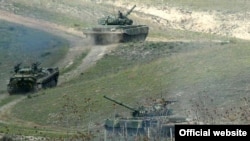The commander-in-chief of Nagorno-Karabakh’s Armenian-backed armed forces said on Thursday that they have acquired significant amounts of new weapons and fortified their frontline positions this year.
“We have made some progress in this area, especially in the provision of new weaponry and ammunition to artillery units,” Lieutenant-General Movses Hakobian told a news conference in Stepanakert. “We have also begun delivering tanks to the army. That will also boost the army’s potential.”
Hakobian declined to give any details of the military buildup.
The general said in August that the “military potential” of his troops grew by 20 percent in the first half of 2011. He listed a “rearmament” of an artillery regiment and new anti-tank and air-defense weapons supplied to a dozen army battalions. “And we will receive more tanks -- two more divisions -- later this year,” he said.
Armenia, whose armed forces are closely connected with the Karabakh military, is likely to be the main source of the arms acquisitions reported by him. Its Karabakh-born Defense Minister Seyran Ohanian said last February that Yerevan obtained “unprecedented” quantities of modern weaponry in 2010.
“The expansion of our military capacity will continue in 2011, and it will be no less large-scale than it was in 2010,” Ohanian told RFE/RL’s Armenian service at the time (Azatutyun.am).
Azerbaijan’s leaders regularly threaten to forcibly win back Karabakh and Armenian-controlled territories surrounding the disputed enclave if the long-running Armenian-Azerbaijani peace talks yield no results acceptable to Baku. The Azerbaijani government has used billions of dollars in oil revenues for a massive military buildup over the past decade.
According to Hakobian, the Azerbaijani threats are taken seriously by the Karabakh Armenian leadership. “Statements by Azerbaijan are a cause for some concern given that behind these words are quite serious weapons and hardware which Azerbaijan keeps buying,” he said. “There has been a certain rise in their combat-readiness.”
Hakobian, who commanded some Karabakh Armenian units during the 1991-1994 war with Azerbaijan, reiterated his earlier statements that large-scale hostilities could resume “at any moment” and that the Armenian side is prepared for them. He described as “very tense” the situation along the main Armenian-Azerbaijani “line of contact” east and north of Karabakh.
In particular, Hakobian spoke of a “worrisome” increase in Azerbaijani sniper activity which he said left 11 Armenian soldiers dead and 34 others wounded on the Karabakh frontline this year.
“We are determined to rein in the enemy and keep it from developing efforts in this direction,” said the general. “For these considerations we have equipped all of our positions in a way that allows us to safely carry out 360-degree observations.”
The Azerbaijani military has not yet released any casualty data for 2011. The Baku daily “Zerkalo” quoted an independent military expert, Uzeir Jafarov, as saying last month that 13 Azerbaijani soldiers were shot dead by the Armenians so far this year.
“We have made some progress in this area, especially in the provision of new weaponry and ammunition to artillery units,” Lieutenant-General Movses Hakobian told a news conference in Stepanakert. “We have also begun delivering tanks to the army. That will also boost the army’s potential.”
Hakobian declined to give any details of the military buildup.
The general said in August that the “military potential” of his troops grew by 20 percent in the first half of 2011. He listed a “rearmament” of an artillery regiment and new anti-tank and air-defense weapons supplied to a dozen army battalions. “And we will receive more tanks -- two more divisions -- later this year,” he said.
Armenia, whose armed forces are closely connected with the Karabakh military, is likely to be the main source of the arms acquisitions reported by him. Its Karabakh-born Defense Minister Seyran Ohanian said last February that Yerevan obtained “unprecedented” quantities of modern weaponry in 2010.
“The expansion of our military capacity will continue in 2011, and it will be no less large-scale than it was in 2010,” Ohanian told RFE/RL’s Armenian service at the time (Azatutyun.am).
Azerbaijan’s leaders regularly threaten to forcibly win back Karabakh and Armenian-controlled territories surrounding the disputed enclave if the long-running Armenian-Azerbaijani peace talks yield no results acceptable to Baku. The Azerbaijani government has used billions of dollars in oil revenues for a massive military buildup over the past decade.
According to Hakobian, the Azerbaijani threats are taken seriously by the Karabakh Armenian leadership. “Statements by Azerbaijan are a cause for some concern given that behind these words are quite serious weapons and hardware which Azerbaijan keeps buying,” he said. “There has been a certain rise in their combat-readiness.”
Hakobian, who commanded some Karabakh Armenian units during the 1991-1994 war with Azerbaijan, reiterated his earlier statements that large-scale hostilities could resume “at any moment” and that the Armenian side is prepared for them. He described as “very tense” the situation along the main Armenian-Azerbaijani “line of contact” east and north of Karabakh.
In particular, Hakobian spoke of a “worrisome” increase in Azerbaijani sniper activity which he said left 11 Armenian soldiers dead and 34 others wounded on the Karabakh frontline this year.
“We are determined to rein in the enemy and keep it from developing efforts in this direction,” said the general. “For these considerations we have equipped all of our positions in a way that allows us to safely carry out 360-degree observations.”
The Azerbaijani military has not yet released any casualty data for 2011. The Baku daily “Zerkalo” quoted an independent military expert, Uzeir Jafarov, as saying last month that 13 Azerbaijani soldiers were shot dead by the Armenians so far this year.




